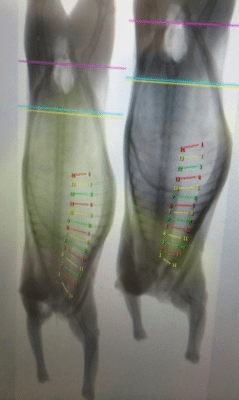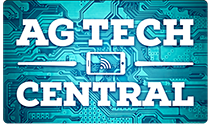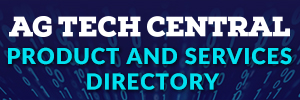THE sheepmeat industry is on the cusp of a processing advance that will pave the way for a long overdue change in the way producers are paid for their livestock, Meat & Livestock Australia says in a press release issued today.

DEXA X-ray images of lamb carcases, with prescribed cutting points designed to optimise yield
Managing director Richard Norton said more than 90 percent of Australia’s sheepmeat processing capacity had now been ‘costed’ for the installation of DEXA objective carcase measurement technology, with the tool already installed at JBS Brooklyn and Bordertown.
Mr Norton described the progress of DEXA within the sheepmeat sector to around 250 sheep producers and industry stakeholders at the Woolworths Lambition event at the Australian Sheep & Wool Show in Bendigo.
The national initiative was first announced by Mr Norton at MLA’s 2016 annual general meeting, when he said MLA would drive a $150 million rollout of objective carcase measurement in 90 AusMeat accredited abattoirs.
He said DEXA would pave the way for scientific measurement of saleable meat yield and a subsequent shift from price averaging underpinned by P8 (beef) and GR (lamb) measurements currently used to pay producers, to a value-based marketing system where producers are paid for the actual quantity and quality of meat produced from each animal.
Other economic benefits provided by DEXA included potential for industry-wide productivity gains through beef and lamb processing automation, genetic improvement and data-based on-farm decision making.
“The benefits of the Australian sheepmeat industry making a wholesale shift to the use of DEXA start with increased supply chain transparency,” Mr Norton said.
“Producers already have a tool for objectively measuring beef eating quality of the meat they’re producing via the Meat Standards Australia program; DEXA will provide an actual measure of the quantity of meat their animals are yielding. It means they can make more informed decisions on farm about the genetics they’re using, their feeding and husbandry practices.”
Independent agencies EY and Greenleaf had verified the whole of industry benefit of using DEXA to increase transparency of how carcases yield and perform, while the Australian Competition and Consumer Commission had also endorsed industry-wide adoption of the MLA initiative, Mr Norton said.
“The reports found the use of DEXA and subsequent enabling of supply chains to meet market specifications more consistently could add $270 million per annum to the red meat industry.”
Mr Norton said a second tranche of economic benefits already being generated by the installation of DEXA systems has come from the accompanying use of more automation in meat processing plants.
“The precision of the DEXA measurement enables the introduction of automated processes that improve cutting accuracy, workplace health and safety, throughput efficiency and shelf life of the product. In plants where these systems are already installed, lamb automation enabled by DEXA has demonstrated a return on investment within a year, of up to $7 per head.
“As we’ve seen with the MSA eating quality system introduced by our industry 20 years ago, the more the industry adopts these objective measurement solutions, the larger the benefits and the faster they will be shared along the entire length of the Australian value chain.”
Mr Norton said with the initial costing of installing DEXA nation-wide completed, the numbers were now being independently verified, following which a total cost and funding model would be put to each of the industry’s peak councils and research and development funding bodies for decision.
Source: MLA


It is good to see the advantages of Dexa particularly for the primary producers of good quality carcasses with a high ratio of lean meat
We need this in our meat plants in ireland also.